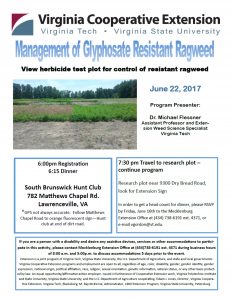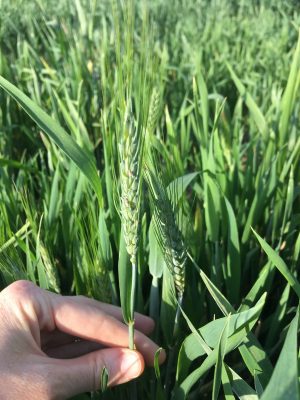The 2017 Virginia Tech Small Grain Variety performance results have been posted.
A copy of the document is available at the following link:
http://www.grains.cses.vt.edu/Testing_results/Small_grains/2017/SG_17_2.pdf
The 2017 Virginia Tech Small Grain Variety performance results have been posted.
A copy of the document is available at the following link:
http://www.grains.cses.vt.edu/Testing_results/Small_grains/2017/SG_17_2.pdf
Having trouble controlling herbicide resistant common ragweed? Make plans to attend the field tour, this coming Thursday (June 22nd, 2017) near Lawrenceville, Virginia. Complete information is below. Please RSVP as soon as possible.
View a complete spectrum of preemergence and postemergence herbicides in soybeans in the field to see what works best for yourself. Also, learn about integrated weed management approaches that work within our cropping systems. 
Coinciding with the wheat harvest, brown stink bugs have been moving into pre-tassel corn in the southeastern region of our Virginia. The entomology department has scouted fields over threshold in Chesapeake and Virginia Beach. So far this season, stink bugs are present in low numbers in northern, central, and western regions of the state.
Thresholds for stink bugs in field corn are (From Dominic Reisig at NCSU):
one stink bug per four plants during ear formation, elongation, and pollen shed
one stink bug per two plants nearing the end of pollen shed to the blister stage.
Plant injury from stink bugs may include:
Holes in leaves and, in severe cases, twisted plants.
It is important to remember that this bug typically infests on edges of fields and in spotty locations. It is possible, though unlikely, that stink bugs will infest an entire field. Spray volume is critical if you decide to spray – use a high volume to ensure that sprays penetrate the canopy. Insecticides labeled for stink bugs in corn (e.g., Baythroid XL, Karate Z, Warrior II) must come into direct contact with insects to kill them.
Following last week’s rain, the risk for Fusarium head blight (FHB or scab) infections has increased, and the risk is very high even for moderately resistant varieties in certain portions of the state (see FHB Risk Map). Much of the wheat crop is beyond the early flowering stage, but for fields where wheat is currently flowering a fungicide may be needed to protect the crop from FHB infection and DON contamination. Recommended fungicides include Caramba, Prosaro, and Proline. Fungicides are most effective when applied at the start of flowering and up to a week later. The greatest coverage of the heads can be achieved by applying fungicides in 5 gal/A by air and 15 gal/A by ground with a 300-350 um droplet size and nozzles angled forward at least 30 degrees.

Wheat is beginning to flower throughout Virginia, so it is time to make decisions about fungicide applications for both Fusarium head blight (FHB, also known as scab) and to protect the flag leaf as the grains begin to form. Currently, the risk for FHB is low in most parts of Virginia, even for susceptible varieties. The FHB Risk Assessment Tool can be found at http://www.wheatscab.psu.edu. Keep in mind that this is a prediction tool and it will not predict FHB outbreaks 100% of the time. A current screen shot of the website is shown below. Rains are expected over the weekend, but dry weather over the past several weeks has not favored spore production by the FHB fungus, so risk of FHB infection is expected to remain low for wheat that is flowering over the next week. However, now may still be the time to apply fungicides for foliar diseases including stripe rust, powdery mildew, and leaf blotch. The flag leaf must be protected during grain development to maximize yields. Again, due to the dry weather some areas have very little disease, and scouting is still recommended prior to making a fungicide application. However, there have been numerous reports throughout the region of outbreaks of stripe rust (especially on Shirley) and powdery mildew. Do NOT apply a strobilurin or fungicide pre-mix containing a strobilurin after flag leaf emergence (Feekes 9) since this can increase DON contamination in the grain. Prosaro, Caramba, and Proline are the most effective products for reducing scab and DON contamination, and these fungicides will also control foliar diseases such as leaf blotch, stripe and leaf rust, and powdery mildew. A fungicide efficacy table for wheat can be found in a previous post.
 Screen shots from the Fusarium Head Blight Risk Assessment Tool (http://www.wheatscab.psu.edu) on April 20, 2017. Currently, risk of FHB infection in wheat that is flowering is low in most parts of Virginia. The exception is along the Eastern Shore where conditions are typically more humid and favorable for spore production by the FHB fungus. For susceptible varieties such as Shirley, FHB risk is moderate to high in some areas. However, for moderately resistant varieties such as Hilliard, the risk is currently low. This illustrates the importance of variety selection in management of FHB and DON contamination in wheat.
Screen shots from the Fusarium Head Blight Risk Assessment Tool (http://www.wheatscab.psu.edu) on April 20, 2017. Currently, risk of FHB infection in wheat that is flowering is low in most parts of Virginia. The exception is along the Eastern Shore where conditions are typically more humid and favorable for spore production by the FHB fungus. For susceptible varieties such as Shirley, FHB risk is moderate to high in some areas. However, for moderately resistant varieties such as Hilliard, the risk is currently low. This illustrates the importance of variety selection in management of FHB and DON contamination in wheat.

Copies of a Wheat Disease Identification Guide from Kansas State are now available and can be requested from Dr. Hillary Mehl at the Tidewater AREC (hlmehl@vt.edu). A PDF version of the guide can be downloaded here. Though not specific to Virginia, many of the diseases included in the guide occur in our region and detailed descriptions of symptoms and management recommendations are included. As always, if confirmation of a disease is needed for wheat or other agronomic crops, plant samples can be submitted to the Virginia Tech Tidewater AREC (6321 Holland Rd. Suffolk, VA 23437). When submitting samples, be sure to fill out the Plant Disease Diagnostic Form with as much information as possible as this will assist us with an accurate diagnosis. The form can be downloaded here: Plant Disease Diagnostic Form

Though it is still a little early to be making scab fungicide applications, it is time to start thinking about if and when to apply a fungicide to the wheat crop. Wheat in parts of Virginia is starting to head, but much of the crop is still at or close to flag leaf emergence. Stripe rust was observed this week in Warsaw, VA and has been confirmed on the Eastern Shore of Virginia and in southeastern Delaware. Stripe rust is likely widespread in the state, and susceptible varieties such as Shirley should be scouted for this disease. Stripe rust can spread very rapidly and a preventative fungicide may be needed to protect the wheat crop. More information on stripe rust and other wheat diseases can be found in a previous post. Wheat that is beginning to head this week will start flowering in a week or two. Currently, Fusarium Head Blight (FHB) risk is low in most parts of the state with a few moderate to high risk areas along the Eastern Shore. As the wheat crop starts to flower, it is important to monitor the FHB risk and apply fungicides as needed. Updates on FHB risk and management recommendations will be provided here and from the FHB Alert system throughout the period of flowering for the Virginia wheat crop. You can sign up for FHB text message and/or email alerts here. Also be sure to check the FHB Risk Tool (http://www.wheatscab.psu.edu/) as the wheat crop starts to flower. If FHB risk is moderate to high, an application of a fungicide (e.g. Prosaro, Caramba) may be needed to protect the crop from scab and DON contamination. An update fungicide efficacy table for wheat can be downloaded here:
On Friday, stripe rust was confirmed on a wheat sample from a field in Northampton County, Virginia. Steve Rideout, Extension Plant Pathologist at the Eastern Shore AREC, reported that infection is fairly severe and rainy conditions will favor the pathogen’s development. This is an early sighting for this disease and constitutes a serious threat to our wheat crop. The disease was found on Shirley, which based on observations in previous years in known to be highly susceptible to stripe rut. A previous post with management recommendations including variety susceptibility ratings and a fungicide efficacy table for stripe rust and other wheat diseases can be found here:
http://blogs.ext.vt.edu/ag-pest-advisory/stripe-rust-found-in-north-carolina-wheat/
You should be scouting your wheat crop at this time, and if stripe rust is found on a susceptible variety, a fungicide application is recommended. If you have any questions or need assistance identifying diseases on your wheat crop, contact Dr. Hillary Mehl at the Tidewater AREC (hlmehl@vt.edu).
Our recent warm weather has done more than wake up your plants – it has signaled to many insects that it is time to start feeding and reproducing. Prompted by a call from ANR agent Mike Parrish in Dinwiddie County, I spoke today with Kathy Flanders at University of Auburn about her recommendations to mitigate insect injury in store grain. Her #1 suggestion – turn on those fans! Your goal should be to keep the temperature inside your bin below 60 degrees. Make sure and leave equipment running long enough to cool the entire structure. If you are unable to keep temperatures below this threshold, or if our nights do not stay cool, make sure to take samples regularly to scout for insect injury. Consult this guide for management recommendations specific to the Southeast: http://www.aces.edu/pubs/docs/I/IPM-0330/IPM-0330.pdf.

This week, stripe rust was found in Robeson County, NC. The disease was observed in wheat variety SS 8404 which is susceptible to stripe rust. Current weather conditions (cool, wet) are generally favorable for spread and development of stripe rust, and it will likely move north into Virginia before the end of the wheat growing season. However, stripe rust is typically a problem only in susceptible varieties. With this in mind, it is important for growers to determine which of their planted varieties are susceptible to stripe rust so they will be prepared to scout and apply a fungicide once the disease makes its way to Virginia. One popular variety, Shirley, is very susceptible to stripe rust, and outbreaks of this disease were observed in some fields planted to Shirley in 2016. Stripe rust and other disease ratings for wheat in Virginia can be found in the link below for the VCE Publication Small Grains in 2016. A link to the Diseases in Small Grains chapter from the 2017 Pest Management Guide for Field Crops is also attached. This includes management recommendations and a fungicide efficacy table for stripe rusts and other diseases of wheat. Several different fungicides are available that are rated “Excellent” for stripe rust control, but fungicides are most effective when applied prior to disease development. Thus, if you know you have a variety is that is susceptible to stripe rust you should be scouting those fields and apply a fungicide if stripe rust is observed. There is no need to spray wheat for stripe rust at this time, but it is important to be aware and be prepared. If you suspect you have stripe rust, you can send a photo and/or sample to Dr. Hillary Mehl at the Tidewater AREC (hlmehl@vt.edu).
Small Grains in 2016 (variety disease susceptibility ratings)